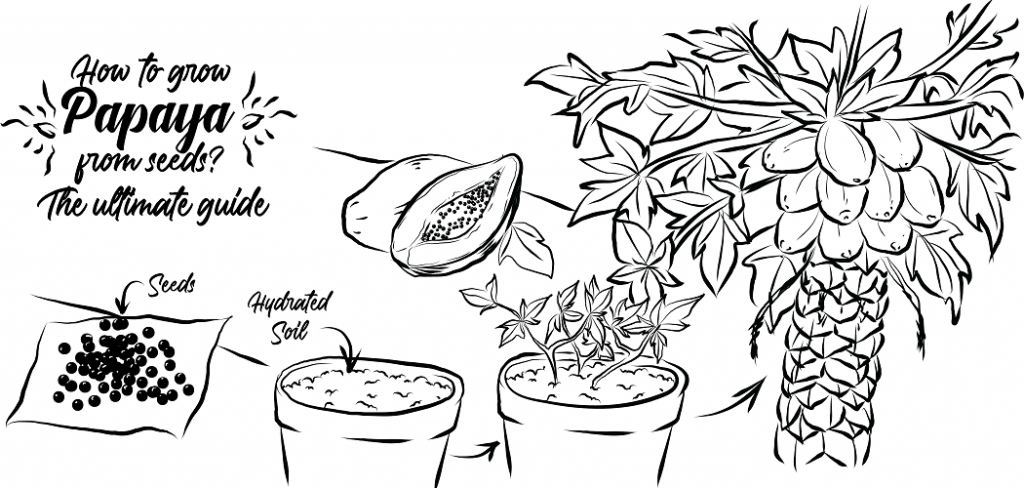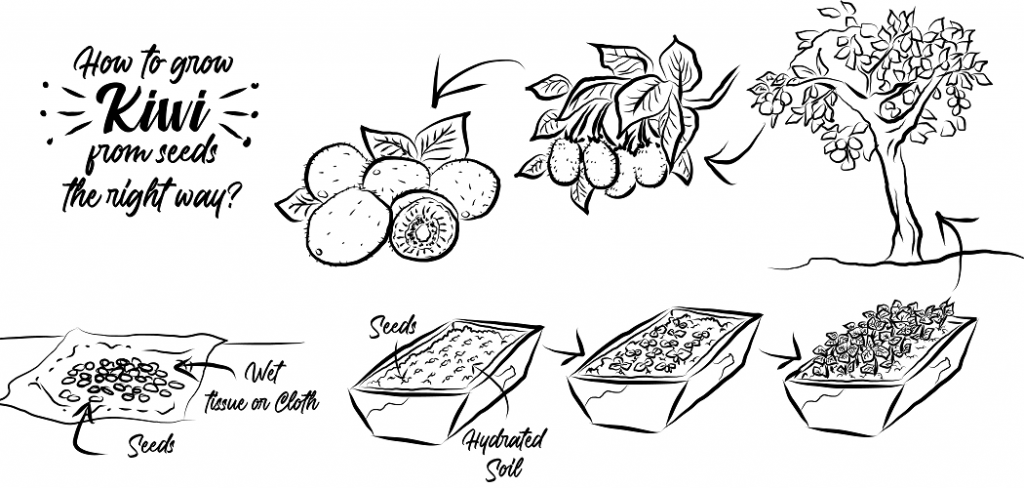
Papaya is a beginner-friendly plant because it’s easy to grow. If you’re a novice with plants, papaya should be on your list of the first plants to grow in your garden. The bonus part is they also bear fruits in no time, and these fruits have a plethora of uses.
When ripe, you can enjoy papaya on its own. The sweetness of papaya is enough to satisfy your sweet tooth. It’s also butter-like and creamy, making it a delicious treat when you’re craving for desserts. The unripe ones are just as good as the ripe ones but they are best suited for savory dishes like chicken soup and stir-fry dishes.
For those who are interested in planting papaya, here are the complete steps on how to grow papaya from seeds. If you have limited outdoor space or you want to grow them indoors, we will also teach you how to grow papaya in pots.
Step-by-Step Guide on How to Grow Papaya from Seeds
Step 1: Gather your seeds from the fruit of your store-bought papaya. You can also purchase them from nurseries or plant stores. These stores usually have an online store, so you can order them from home.
Step 2: Plant the seeds in your garden. You don’t really need to do anything with the seeds but you can wash them with water just to get rid of the arils surrounding the seeds. If it’s not possible, you can grow them in containers or pots. How long does it take for a papaya tree to grow from seed? That depends, but the germination alone takes a couple of weeks.
Papayas need at least 1.5 meters or about 5 feet of space between each other. Since they are tropical fruits, they grow best in hot areas.
Step 3: Place the papaya in a protected area in your house. They can be easily damaged by harsh wind so it’s important that they are in a sheltered location. They also don’t tolerate extremely cold temperatures. They can survive a little frost provided that they are protected from coldwinds.
Step 4: Water the papaya regularly, but make sure not to overwater your tree or it will die. Many expert gardeners only recommend watering the papaya tree every two weeks especially during the dry season.
Papaya thrives in well drained soil. The roots may get some forms ofplan diseases if it stays wet too often. Loamy soil is best for the seeds, but it can grow in most kinds of soil.
Step 5: You can use epsom salt to fertilize your papaya tree. For every litre of warm water, add a tablespoon of epsom salt. Put the solution on a spray bottle and use it to fertilize the papaya every three months. Spray the solution on the leaves to make your tree grow faster.
More Papaya Plant Care Tips
Papaya thrives in a warm climate. But because it’s a tropical fruit, it can survive even in cold weather. As long as the temperature is not freezing, you don’t have to worry about your papaya plant dying. You can plant papayas at any time of the year, as long as it is not too cold for the papaya’s tolerance. But the best time to plant papaya seeds is in the late summer.
Keep in mind that the roots of papaya are shallow so it’s hard for them to grow in wet conditions. To guarantee the growth of your papaya tree, use well-draining soil. By using a well-draining soil, you can guarantee your plant will have enough time to absorb water and nutrients.
Papaya trees can grow very tall. You might be wondering how to shorten papaya tree. The best way to do it is to cut an inch off each time the papaya grows 5 inches taller. Trimming your new tree allows for a thicker trunk to grow.
How to Harvest Your Papaya

You can start harvesting your papaya after nine months or a year because by this time your tree should already bear fruits. Take note, though, that only female papayas produce fruits. Male papaya should be pruned to make it productive.
Papayas can also be hermaphrodite or both male and female. This gender of papaya can bear fruits without undergoing pollination. That’s why many farmers prefer this kind of papaya.
Just keep in mind that a hermaphrodite papaya can also turn male or female. It is capable of changing genders.
You can change the orientation of your papaya plant by inserting a barbecue stick on the bottom of the plant. The goal is to stress the tree so it will be converted to female. A papaya is female if the flowers bloom close to the trunk. The flower is large and single, unlike male papayas with several flowers.
Female papayas need to be pollinated by the male papaya trees. For every ten female papaya trees you have, you leave at least one male for productive pollination.
You can start harvesting the papaya fruits once their skins turn yellow. They will not yet be truly ripe then, but they will soften and ripen up when picked from the tree. Be sure to handle them very carefully because papaya fruits get easily bruised. Bruised papaya fruits are too soft and mushy, they are not as versatile as firm papayas.
What You can Do with Papaya
Papaya is quite a versatile fruit. It can be served with a lot of dishes, especially if not ripe. Not only that, even its leaves, flowers and seeds have been known to be useful in the culinary world.
If you are looking to increase the nutritional value of your meals while elevating the taste value, papaya is a good option. You can try the Hawaiian papaya salad, the Indian Papite ka Halwa, or the Oriya savory curry called santula.
Just Google papaya recipes, and you will never run out of options. Of course, if you do not feel like cooking, you can simply eat the papaya raw. Aside from the benefits of its culinary versatility, the papaya fruit also has a lot to offer when it comes to its nutritional value.
Health Benefits of Eating Papaya
Papaya is rich in vitamins and minerals. It contains Vitamins A, C, and E. It also has potassium, calcium, magnesium, and phosphorus among others. It’s a good source of dietary fibers and healthy fats.
It is among the best fruits for gut health. If you’re suffering from bloat and constipation, you can eat papaya to ease digestion. The papain and the fibers in the fruit help maintain regular bowel movement. It’s best to eat papaya on its own if you want to get the most out of it. You can also use them as ingredients for salads and desserts.
Papaya contains numerous enzymes which helps break down the food in your stomach. Eating papaya an hour before or after a meal will greatly help your digestive system.
Papaya is also a hydrating food. Did you know that papaya is composed of up to 80 percent of water? The high water content of papaya helps you stay hydrated throughout the day. It’s best to eat it after a large meal or after eating meat to make it easier to digest. Because of its high water content, it’s recommended as a snack for people trying to lose weight.
How would you like to have better skin health? Did you know that papaya is extremely rich in vitamin E? Vitamin E packs quite the antioxidant dose. AHA is also part of the papaya nutritional arsenal. AHA removes dead skin cells and repairs cell tissues. Basically, papaya is a natural skin exfoliating medicine.
It also has other health benefits. It improves the immune system, helps in weight loss, awesome for diabetes prevention, better heart health and whole lot of other health benefits.
How Long Does it Take for a Papaya Tree to Grow from a Seed?
Growing papaya from seeds is easier than you think. With an optimal location and proper watering, you can see your papaya grow quickly. It also helps to know the best type of soil needed for your papaya tree to grow fast. These factors dictate how long does it take for a papaya tree to grow from seed.
Some people are not blessed with a huge farm for growing plants like papaya. But as with any fruit-bearing plant, it’s possible to grow them in containers. Just remember, transplanting them may require more care because papaya has sensitive roots.
Conclusion
Papaya is a low-maintenance tree. Aside from knowing if you have a female or male tree, there’s nothing much to worry about growing them. You can easily start enjoying your papaya after just less than a year.
We have other guides on how to grow fruit-bearing trees like durian or kiwi. Check them out!


